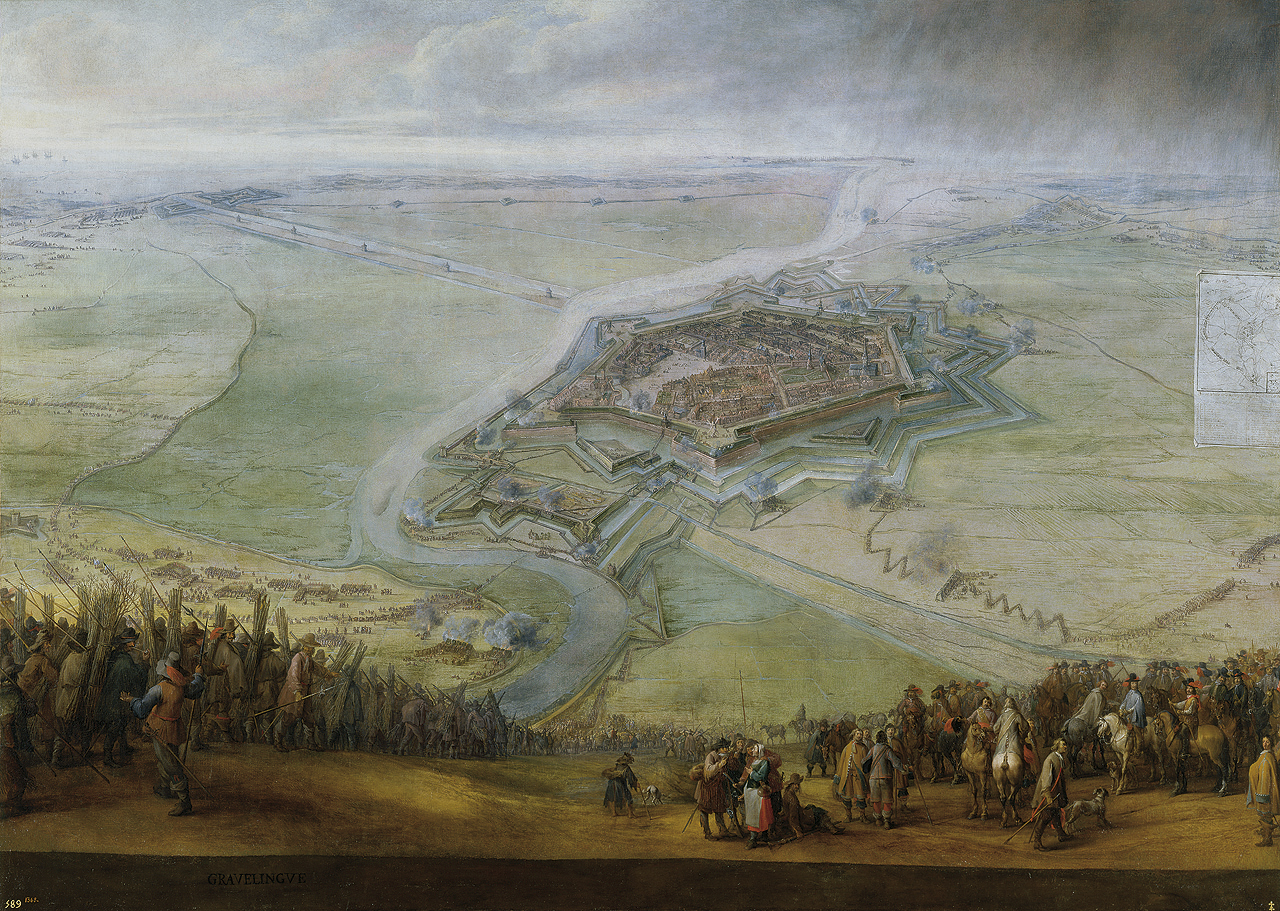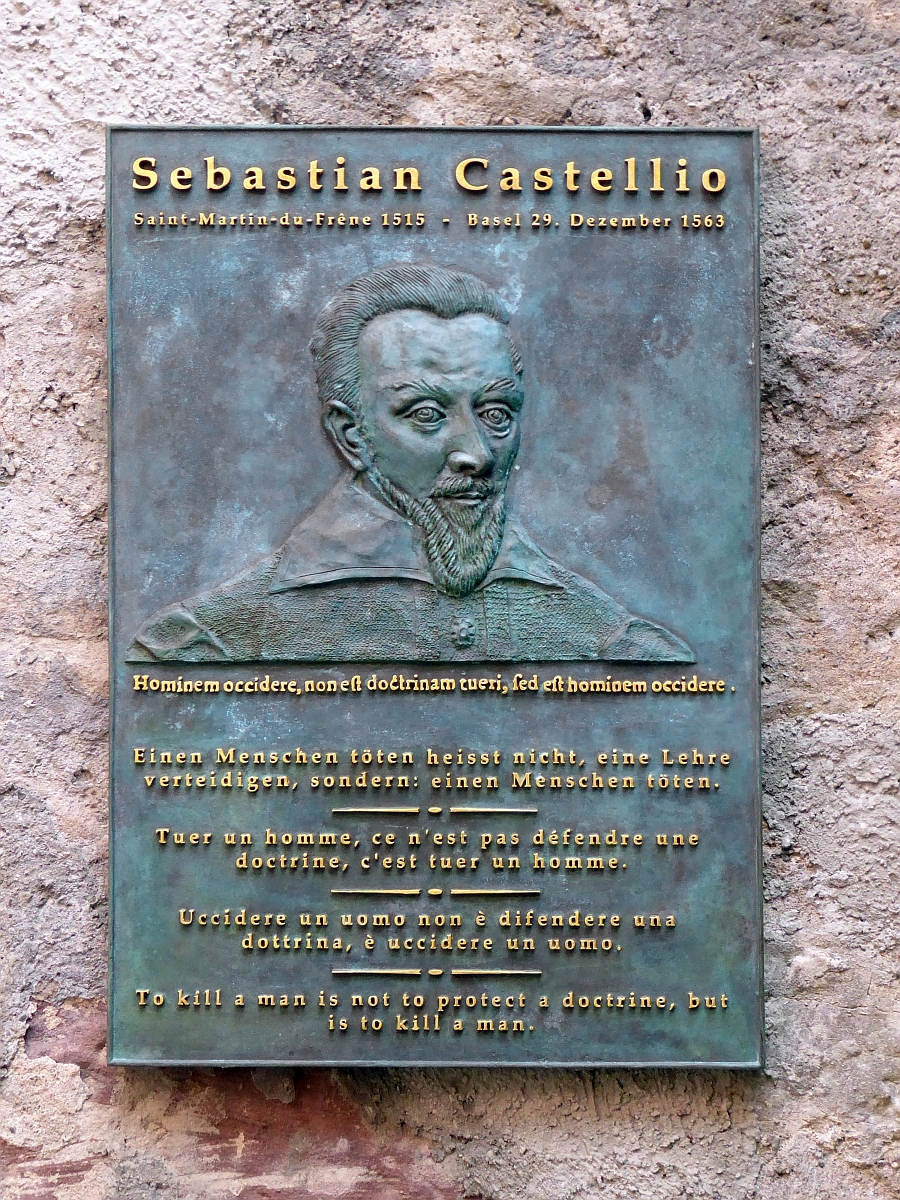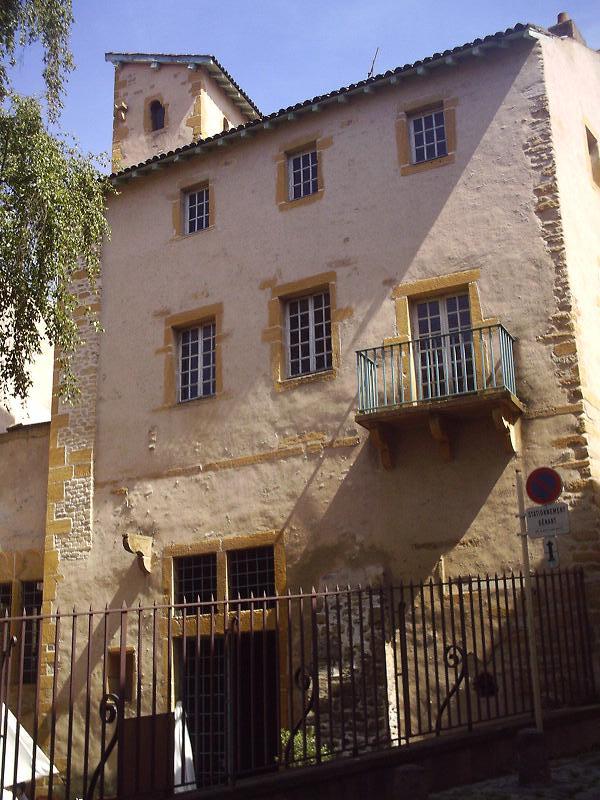|
Johann Herwagen
Johann Herwagen or Johann Herwagen the Elder, known as Hervagius (1497 in Hegau - 1557–1558 in Basel) was a Swiss Protestant publisher. In contact with numerous European intellectuals, he was actively involved and made his mark in the dissemination and propagation of early ideas of the Reformation and the Renaissance. Biography He was born in 1497 in Hegau. He was one of the first Protestant publishers, and he edited Luther's texts in the 1520s. He stayed in Strasbourg from 1523 to 1528. The publisher was very close to Johann Froben, and both were significant in the spread of Renaissance and Reformation ideas. In 1526, shortly after his death, he married his widow, Gertrude Lachner. His good knowledge of Greek and Latin allowed him to intervene directly and be consulted in case of printing disputes. During his lifetime, he was recognized as an important publisher and was nicknamed by his Latin name, Hervagius. He was relatively close to Erasmus, among others, ... [...More Info...] [...Related Items...] OR: [Wikipedia] [Google] [Baidu] |
Hegau
The Hegau is an extinct volcanic landscape in southern Germany extending around the industrial city of Singen (Hohentwiel), between Lake Constance in the east, the Rhine River in the south, the Danube River in the north and the Randen—as the southwestern mountains of the Swabian Jura are called—in the west. It was first mentioned in A.D. 787 in the Latinised form ''in pago Egauinsse''.Albert Krieger: Topographisches Wörterbuch des Großherzogtums Baden, Vol. 1, p. 882 (1904)' The most famous sight of the Hegau is the Hohentwiel Hohentwiel is an extinct volcano in the Hegau region of Baden-Württemberg in southern Germany The mountain is west of the city of Singen and 20 miles (30 km) from Lake Constance. Hohentwiel began forming, along with the chain of vol ..., a volcanic stub. On top of the mountain lies Hohentwiel fortress. The Hohentwiel is the southernmost of a row of volcanic stubs in the Hegau, including the Hohenkrähen, the Hohenstoffeln, and the H ... [...More Info...] [...Related Items...] OR: [Wikipedia] [Google] [Baidu] |
1558 Deaths
__NOTOC__ Year 1558 ( MDLVIII) was a common year starting on Saturday (link will display the full calendar) of the Julian calendar. Events January–June * January 7 – French troops, led by Francis, Duke of Guise, take Calais, the last continental possession of the Kingdom of England, in the Siege of Calais. * January 22 – The Livonian War begins. * February 2 – The University of Jena is founded in Thuringia, Germany. * February 5 – Arauco War: Pedro de Avendaño, with sixty men, captures Caupolicán (the Mapuche Gran Toqui), who is leading their first revolt against the Spanish Empire (near Antihuala), encamped with a small band of followers. * March 8 – The city of Pori ( sv, Björneborg) was founded by Duke John on the shores of the Gulf of Bothnia. * April 24 – Mary, Queen of Scots, marries Francis, Dauphin of France, at Notre Dame de Paris. July–December * July 13 – Battle of Gravelines: In France, Spanish fo ... [...More Info...] [...Related Items...] OR: [Wikipedia] [Google] [Baidu] |
1497 Births
Year 1497 ( MCDXCVII) was a common year starting on Sunday (link will display the full calendar) of the Julian calendar. Events January–December * February 7 (Shrove Tuesday) – Followers of Girolamo Savonarola burn thousands of "immoral" objects, at the ''Bonfire of the Vanities'' in Florence. * May – The Cornish Rebellion breaks out in England, incited by war taxes. * May 10 – Amerigo Vespucci allegedly leaves Cádiz, for his first voyage to the New World. * May 12 – Pope Alexander VI excommunicates Girolamo Savonarola. * May 20 – John Cabot sets sail from Bristol, on the ship ''Matthew'' (principally owned by Richard Amerike), looking for new lands to the west (some sources give a May 2 date). * June 13 – The Catholic Monarchs issue the ordinance of Medina del Campo, creating a money system based on the copper maravedí, creating the peso of 34 maravedis. In the next three centuries, this system will dominate international pay ... [...More Info...] [...Related Items...] OR: [Wikipedia] [Google] [Baidu] |
John Chrysostom
John Chrysostom (; gr, Ἰωάννης ὁ Χρυσόστομος; 14 September 407) was an important Early Church Father who served as archbishop of Constantinople. He is known for his homilies, preaching and public speaking, his denunciation of abuse of authority by both ecclesiastical and political leaders, his ''Divine Liturgy of Saint John Chrysostom'', and his ascetic sensibilities. The epithet (''Chrysostomos'', anglicized as Chrysostom) means "golden-mouthed" in Greek and denotes his celebrated eloquence. Chrysostom was among the most prolific authors in the early Christian Church, although both Origen, Origen of Alexandria and Augustine of Hippo exceeded Chrysostom. He is honoured as a saint in the Oriental Orthodox Church, Oriental Orthodox, Eastern Orthodox Church, Eastern Orthodox, Catholic Church, Catholic, Anglican, and Lutheran churches, as well as in some others. The Eastern Orthodox, together with the Byzantine Rite, Byzantine Eastern Catholic Churches, Cat ... [...More Info...] [...Related Items...] OR: [Wikipedia] [Google] [Baidu] |
Church Fathers
The Church Fathers, Early Church Fathers, Christian Fathers, or Fathers of the Church were ancient and influential Christian theologians and writers who established the intellectual and doctrinal foundations of Christianity. The historical period in which they worked became known as the Patristic Era and spans approximately from the late 1st to mid-8th centuries, flourishing in particular during the 4th and 5th centuries, when Christianity was in the process of establishing itself as the state church of the Roman Empire. In traditional dogmatic theology, authors considered Church Fathers are treated as authoritative, and a somewhat restrictive definition is used. The academic field of patristics, the study of the Church Fathers, has extended the scope of the term, and there is no definitive list. Some, such as Origen and Tertullian, made major contributions to the development of later Christian theology, but certain elements of their teaching were later condemned. Great Fathe ... [...More Info...] [...Related Items...] OR: [Wikipedia] [Google] [Baidu] |
Patristics
Patristics or patrology is the study of the early Christian writers who are designated Church Fathers. The names derive from the combined forms of Latin ''pater'' and Greek ''patḗr'' (father). The period is generally considered to run from the end of New Testament times or end of the Apostolic Age () to either AD 451 (the date of the Council of Chalcedon) or to the Second Council of Nicaea in 787. Eras The Church Fathers are generally divided into the Ante-Nicene Fathers, those who lived and wrote before the Council of Nicaea (325) and the Nicene and Post-Nicene Fathers, those who lived and wrote after 325. Also, the division of the Fathers into Greek and Latin writers is also common. Some of the most prominent Greek Fathers are Justin Martyr, Athanasius of Alexandria, Basil of Caesarea, Gregory of Nazianzus, John Chrysostom, Cyril of Alexandria, and Maximus the Confessor. Among the Latin Fathers are Tertullian, Cyprian, Jerome, Ambrose of Milan, Augustine of Hippo, and ... [...More Info...] [...Related Items...] OR: [Wikipedia] [Google] [Baidu] |
Castellio Bible
The Castellio Bible, also known as the Idiot Bible, in full The Bible newly translated, with the continuation of history from the time of Ezra to the Maccabees, and from the Maccabees to Christ (in ), is a French translation of the Bible made by Sebastian Castellio and published in 1555 by Johann Herwagen in Basel. It is, along with the Olivetan Bible, one of the earliest French Bibles based on Hebrew and Greek rather than the Latin Vulgate. If it quickly fell into obscurity after its publication, it innovated in many perspectives regarding the translation of the Bible, starting with its central focus on being understandable to the widest possible audience. History Context Castellio was a Protestant humanist theologian who initially worked in Strasbourg before moving to Geneva to assist John Calvin. Quickly disillusioned by the nascent theocracy, he grew increasingly critical of Calvin and left the town. He later took refuge in Basel and obtained a teaching positi ... [...More Info...] [...Related Items...] OR: [Wikipedia] [Google] [Baidu] |
Sebastian Castellio
Sebastian Castellio (also Sébastien Châteillon, Châtaillon, Castellión, and Castello; 1515 – 29 December 1563) was a French preacher and theologian; and one of the first Reformed Christian proponents of religious toleration, freedom of conscience and thought. Introduction Castellio was born in 1515 at Saint-Martin-du-Frêne in the village of Bresse of Dauphiné, the country bordering Switzerland, France, and Savoy. Under the Savoyard rule his family called itself Chateillon, Chatillon, or Chataillon. Having been educated at the age of twenty at the University of Lyon, Castellio was fluent in both French and Italian, and became an expert in Latin, Hebrew and Greek as well. Subsequently, he learned German as he started to write theological works in the various languages of Europe. His education, zeal and theological knowledge were so outstanding that he was considered to be one of the most learned men of his time - equal, if not superior, to John Calvin. Regarding Cas ... [...More Info...] [...Related Items...] OR: [Wikipedia] [Google] [Baidu] |
François Rabelais
François Rabelais ( , , ; born between 1483 and 1494; died 1553) was a French Renaissance writer, physician, Renaissance humanist, monk and Greek scholar. He is primarily known as a writer of satire, of the grotesque, and of bawdy jokes and songs. Ecclesiastical yet anticlerical, Christian yet considered by some as a free thinker, a doctor yet having the image of a '' bon vivant'', the multiple facets of his personality sometimes seem contradictory. Caught up in the religious and political turmoil of the Reformation, Rabelais showed himself to be both sensitive and critical towards the great questions of his time. Subsequently, the views of his life and work have evolved according to the times and currents of thought. An admirer of Erasmus, through parody and satire Rabelais fought for tolerance, peace, an evangelical faith, and a return to the knowledge of ancient Greco-Romans to dispel the "Gothic darkness" that characterized the Middle Ages. He took up the theses of P ... [...More Info...] [...Related Items...] OR: [Wikipedia] [Google] [Baidu] |
Mathematics
Mathematics is an area of knowledge that includes the topics of numbers, formulas and related structures, shapes and the spaces in which they are contained, and quantities and their changes. These topics are represented in modern mathematics with the major subdisciplines of number theory, algebra, geometry, and analysis, respectively. There is no general consensus among mathematicians about a common definition for their academic discipline. Most mathematical activity involves the discovery of properties of abstract objects and the use of pure reason to prove them. These objects consist of either abstractions from nature orin modern mathematicsentities that are stipulated to have certain properties, called axioms. A ''proof'' consists of a succession of applications of deductive rules to already established results. These results include previously proved theorems, axioms, andin case of abstraction from naturesome basic properties that are considered true starting points of ... [...More Info...] [...Related Items...] OR: [Wikipedia] [Google] [Baidu] |
Bede
Bede ( ; ang, Bǣda , ; 672/326 May 735), also known as Saint Bede, The Venerable Bede, and Bede the Venerable ( la, Beda Venerabilis), was an English monk at the monastery of St Peter and its companion monastery of St Paul in the Kingdom of Northumbria of the Angles (contemporarily Monkwearmouth–Jarrow Abbey in Tyne and Wear, England). Born on lands belonging to the twin monastery of Monkwearmouth–Jarrow in present-day Tyne and Wear, Bede was sent to Monkwearmouth at the age of seven and later joined Abbot Ceolfrith at Jarrow. Both of them survived a plague that struck in 686 and killed a majority of the population there. While Bede spent most of his life in the monastery, he travelled to several abbeys and monasteries across the British Isles, even visiting the archbishop of York and King Ceolwulf of Northumbria. He was an author, teacher (Alcuin was a student of one of his pupils), and scholar, and his most famous work, ''Ecclesiastical History of the English People ... [...More Info...] [...Related Items...] OR: [Wikipedia] [Google] [Baidu] |






